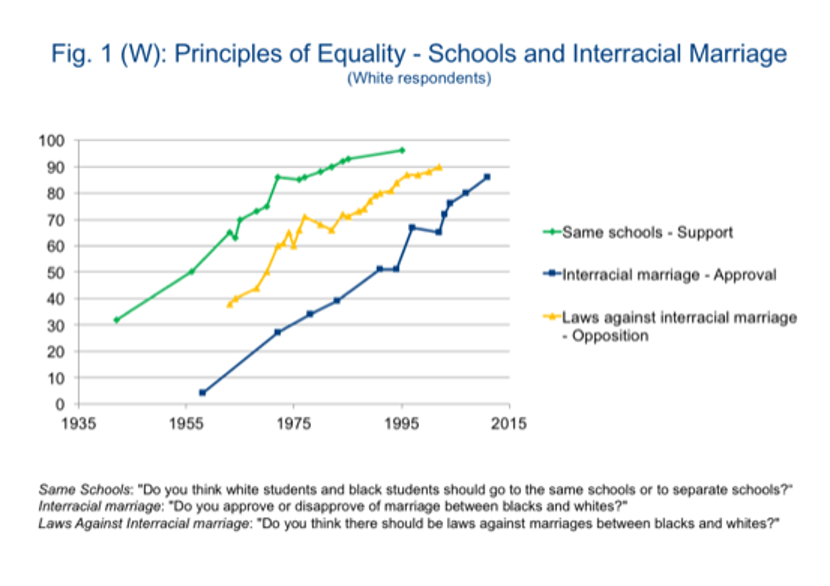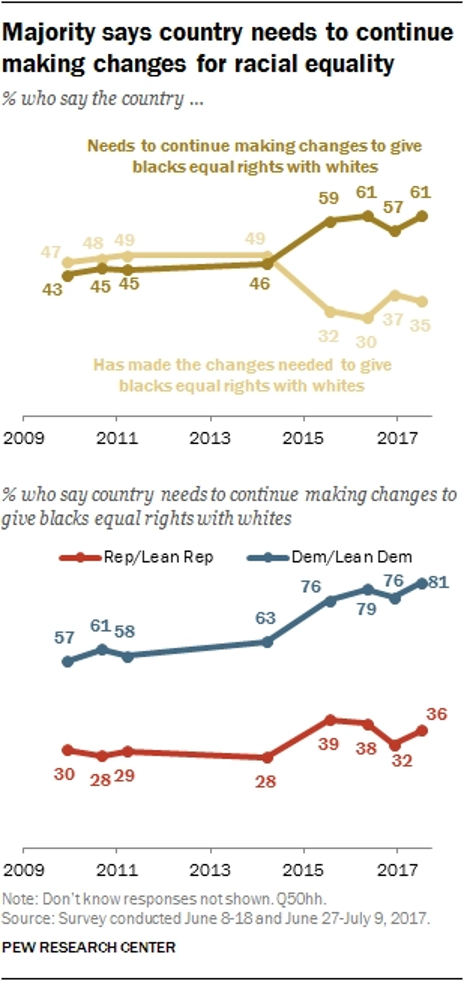
Higher education has begun a transformation similar to the Chinese “Cultural Revolution” of 1966. This claim may sound extreme, but look at the similarities for yourself. Like the Cultural Revolution, the energized identity-politics movement presents itself as a cleansing force. Pure Maoism was being corrupted by covert capitalist sympathizers—they had to be rooted out. In the U.S., the “party faithful” took for granted the permanent problems of “white privilege” and “systemic racism,” which, for many, were their livelihood. But then, after the civil rights acts, things began to look up. In recent decades racism seemed to be slowly disappearing.
Data, like the graph above, from a University of Illinois survey, showed a steady declinein objective measures of racism from 1937 until 2014. The survey concluded: “One of the most substantial changes in white racial attitudes has been the movement from very substantial opposition to the principle of racial equality to one of almost universal support.”
This steady improvement in racial attitudes increasingly conflicted with the “party doctrine” that racism is the inexpugnable American sin. A decline in racism soon produced a backlash from the anti-racists. They promulgated a gloomier narrative, and it has been effective.
The two graphs below, from the Pew Center, show a sharp change in racial attitudes beginning just a few years ago. People have shifted from being relatively content with the state of race relations in America toward dissatisfaction. The change was not spontaneous. It has coincided with efforts to sow racial anxiety despite a slow improvement in objective measures of racism.
There is much evidence for this, but here I will focus on a recent development: a petition/op-ed about combating “systemic racism” in STEM1 that Science (one of the two leading general-science journals) has agreed to publish. You can read the full piece “Systemic Racism in Higher Education” here; I will discuss just a few of its key assumptions.
Quoting from the petition:
Everyone in academia must acknowledge the role that universities—faculty, staff, and students—play in perpetuating structural racism by subjecting students of color to unwelcoming academic cultures…The misuse of standardized tests, like the GRE, excludes students who could have otherwise succeeded.
Structural (aka systemic, institutional) racism is nowhere defined in the petition. The words could be replaced by evil spirits without loss of meaning. In fact, the evidence for this nebulous concept is weak, and it seems often to be a way of deflecting attention from other causes of racial disparities. Careful examination of a specific issue (such as police brutality) usually points to measurable causes of observed disparities, with no need to invoke an abstraction.
The GRE, like any predictive test, is not perfect: it fails some strong applicants and passes a small number of weak ones. But the study referenced in the petition2 seems to fault the GRE primarily because women and minorities don’t do as well on it as men do, rather than because it is an imperfect predictor of success in graduate school.
What is meant by “unwelcoming academic cultures”? There are two obvious possibilities: racism, pure and simple, or some kind of problem with the type and level of academic discussion compared with the environment to which some students are accustomed.
The evidence for any kind of overt racism in academe is negligible and would surely lead to strong correctives if it emerged. What remains is just that the disciplines of STEM are difficult, possibly too difficult for students who have been admitted with weaker-than-average qualifications. Human beings are not equally good at everything. Mathematics, particularly, separates the wheat from the chaff in dramatic fashion. Some people (your humble correspondent, for example) just can’t handle tough math. If this is the problem, some students will either drop out or—and this is the pressure now—will clamor for changes in the curriculum. If these changes are made, the results will likely be disastrous for the quality of science education.
Reducing structural racism in higher education will require evidence-based, institution-wide approaches that focus on achieving equity in student learning. If we abandon the perception of “fixed” student ability, more BIPOC3 students will succeed.
The assumption here is that essentially any student is capable of succeeding. But at what? Not at everything. People are not equal; not everyone can master quaternions. The petition assumes that ineradicable individual differences do not exist, which is simply wrong. By all means, give the best education you can. But do not expect to educate everybody, especially in tough STEM subjects. People are not all equally able. An educational system that pretends they are will end in mediocrity.
BIPOC faculty are further disadvantaged in tenure decisions through cultural taxation of unequal service and mentoring demands. Given these burdens, BIPOC faculty cannot be expected to be the agents of change. Instead, nonmarginalized faculty…should exercise that power by joining BIPOC faculty in prioritizing recruiting, supporting, and championing diversity.
This is an extraordinary demand. It tells BIPOC that they are incapable because of overwork and thus must be given special privileges. (And what is cultural taxation?) Why are they overworked? Is it perhaps because BIPOC students must be mentored by BIPOC faculty? Why is this necessary? Are they put on too many committees? Then put them on fewer. Why can’t these supposed problems be mitigated? Why can’t BIPOC faculty be as independent as others? Assuming that they need help from the non-BIPOC is condescending not to say racist. (And how will more diversity help?)
[These changes] will require making tenure dependent not only on excellence in research, teaching, and service, but also meaningful contributions to promote equity and inclusion….All faculty should examine their courses for performance disparities based on ethnicity and gender, ask whether departmental and lab demographics reflect society at large, and work to remedy disparities.
Enter the commissars. In the future it will no longer be sufficient to teach well and perform excellent research—faculty must also commit to eliminating disparities, which are as likely to be the result of differences in interest and talent as to inadequate teaching. Faculty are to scrutinize their grade distributions to see that BIPOC do not fall behind. What if they do? Whose fault is that? The commissars know and so do the faculty. The pressure to adjust evaluation so as to eliminate disparities will be strong. It is hard to imagine a more damaging injection of politics into research and scholarship.
If these efforts to eliminate disparities in all parts of academia, to match racial proportions in STEM to those in society (and even overrepresent minorities), if they succeed, they will spark a cultural revolution indeed. Science is already in trouble4; a successful effort to make it conform to political ends will turn higher education into social work and wreck the nation’s scientific prestige and production.
1 Science, Technology, Engineering and Math.
2 C. Miller, K. Stassun, A test that fails. Nature 510, 303 (2014).
3 Black Indigenous and People Of Color
4 See, for example, Staddon, John (2020) Review of Stuart Ritchie Science Fictions: How Fraud, Bias, Negligence, and Hype Undermine the Search for Truth (New York: Henry Holt, 2020) Academic Questions, in press.
Image: 人民画报, Public Domain

